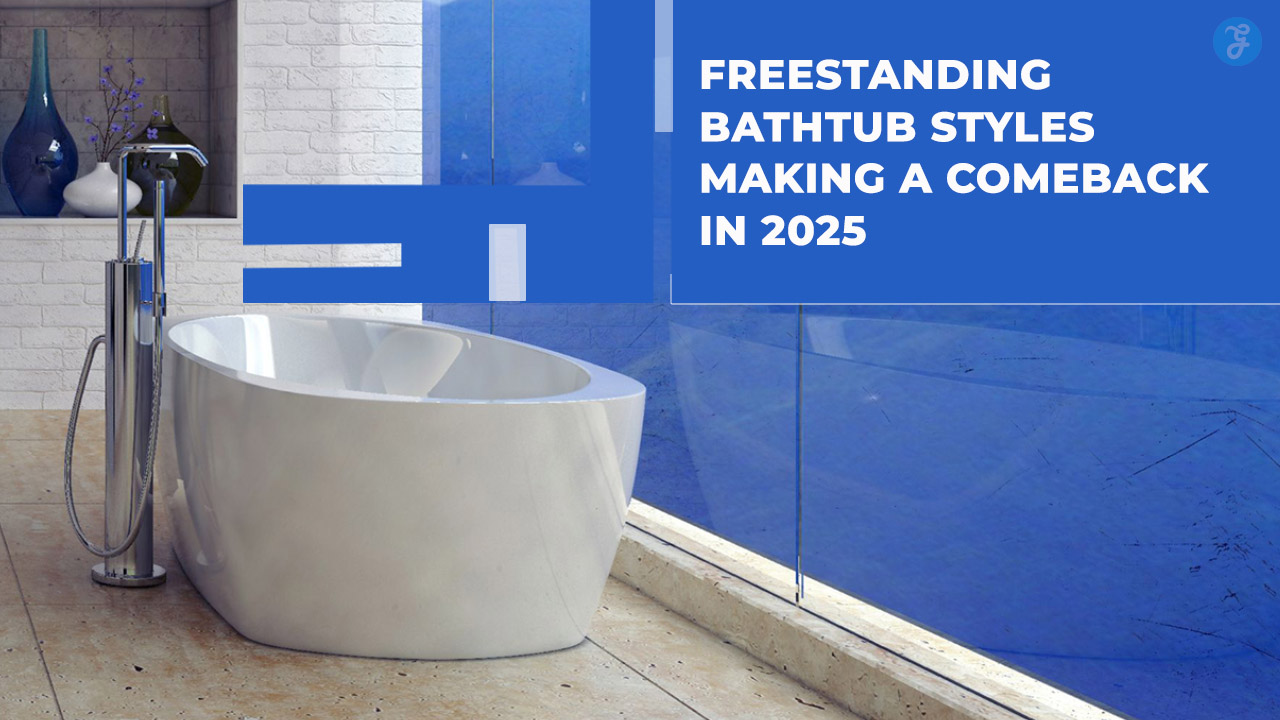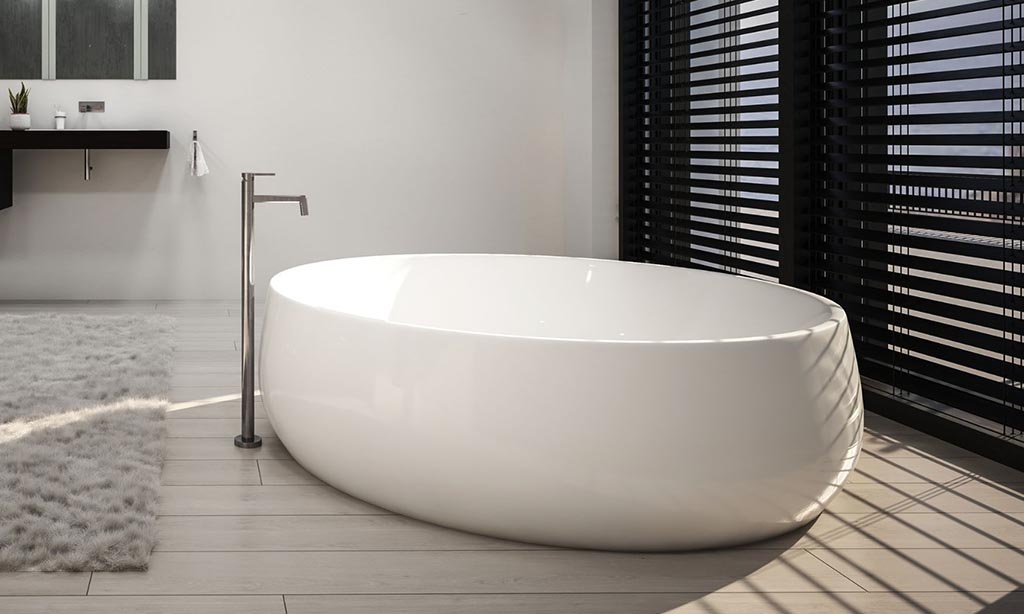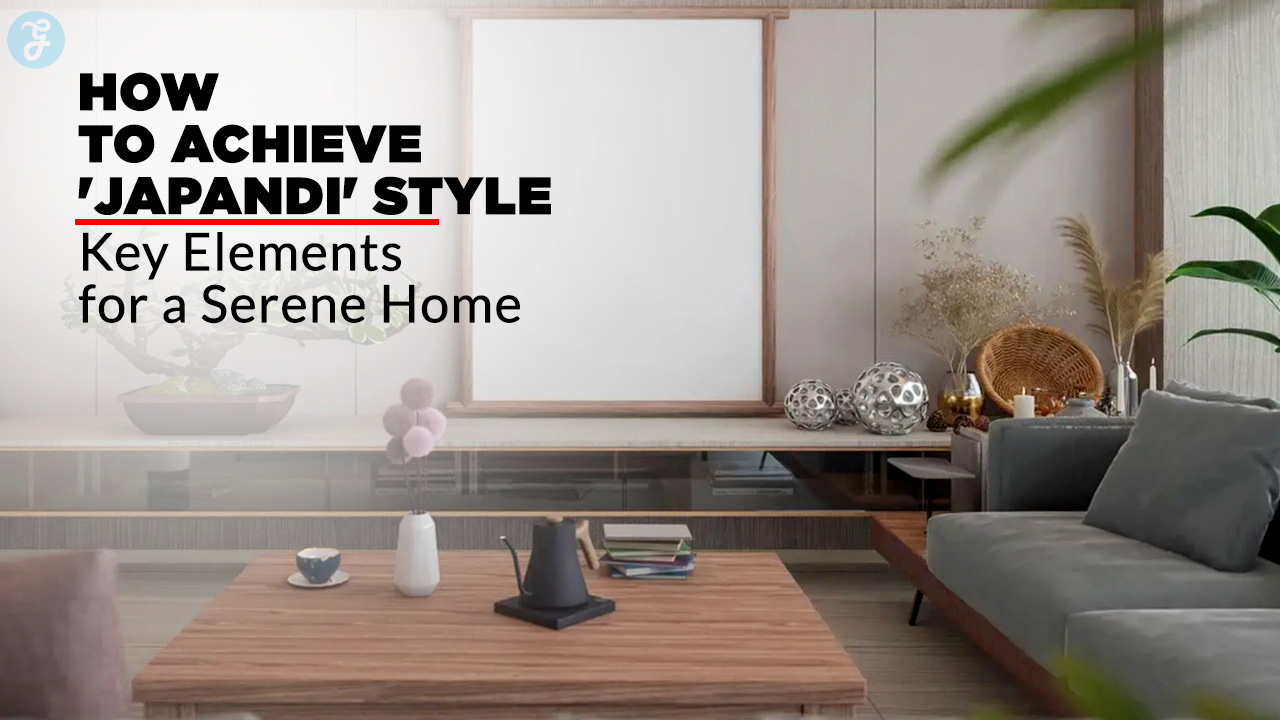Picking a new tub feels like a puzzle. You want a spa-like experience at home. You worry if a clawfoot tub fits your bathroom design. You fear you might pick the wrong size or material.
A survey by the National Kitchen & Bath Association and the U.S. Houzz Bathroom Trends Study finds freestanding tubs will rule 2025. We list seven styles you will love. We show oval soaking tubs, concrete tubs, natural wood tubs, modern minimalist tubs, Japanese soaking tubs, custom color tubs, and high-tech tubs.
We share tips on stone resin, acrylic, and copper. We cover space, layout, and style for your washroom or wet room. Ready to level up your bathroom remodel? Keep reading.
Key Takeaways
- A survey by the National Kitchen & Bath Association and the U.S. Houzz Bathroom Trends Study finds freestanding tubs will rule 2025, led by seven styles: oval soaking, concrete, natural wood, modern minimalist, Japanese soaking, custom color, and high-tech.
- Oval soaking tubs claim 42% of remodelers in 2024 with flat-bottom, deeper curves; Ofuro-inspired Japanese tubs fit 5×5-ft spots and reach 32 inches deep for full-body soaks.
- Stone resin, acrylic, and copper top material picks: 60% of homeowners choose lightweight acrylic, stone resin holds heat like marble, and copper tubs start over $5,000 and develop a green patina.
- Freestanding concrete tubs cost $1,200–$4,000, resist wear, and use rebar for strength; installation runs $1,500–$3,000 for pipes, drains, and labor.
- Eighty-five percent of U.S. designers expect freestanding tub demand to climb through 2025, driving smart features like hydrotherapy jets, chromatherapy LEDs, and built-in speakers.
Oval Freestanding Soaking Tubs
Oval freestanding soaking tubs fit many bathroom designs. They offer a spa-like experience in any layout. The 2024 U.S. Houzz Bathroom Trends Study shows 42% of bathroom remodelers picked a flat-bottom freestanding tub.
Designers add them in wet rooms. Curved lines break straight edges and soften the space.
A deeper tub boosts comfort. People soak longer in round shapes. Warm bubble baths feel indulgent. Remodelers use SketchUp to test placement. Builders check scale and plumbing before install.
This step saves time and cuts mistakes.
Freestanding Concrete Bathtubs
Freestanding concrete tubs shine in spa-like bathroom design. Designers pair them with natural materials like wood shelves. Luxury bath makers install them in high-end remodels. These earth-tone fixtures fit wet rooms or open layouts.
A concrete mixer blends cement, sand and pebbles. Then a mold shapes the tub into smooth, organic curves.
They stand rough use, resist abrasive cleansers. Builders add rebar in formwork for heft and strength. Prices start at $1,200 and climb to $4,000. Homeowners pick them for long life and custom shape.
Natural Wood Freestanding Tubs
Wood tubs bring warm tones, like a spa glow, to your bathroom. Alfi’s oak model looks like fine furniture, with grain that pops. Owners oil and reseal it every few months, to stave off cracks.
The tub lasts under 10 years, shorter than most freestanding tubs. This design suits wet rooms and modern bathroom layouts.
High price tags push some buyers to tweak mortgages or credit lines. You can fit whirlpool jets, but heavy water tests wood seals. Some pair this tub with Japanese soaking tubs for a spa-like vibe.
Others mix clawfoot tubs or composite material shells, to cut costs.
Modern Minimalist Bathtubs
Bold shapes keep freestanding tubs crisp and neat. They echo alcove tubs that slip between three walls, for a space-saving hint, yet they stand free on the floor. Many models pack daily shower combos into one spot.
Designers make them larger and deeper, sculpted in acrylic or gleaming enameled cast iron, and some add bamboo trays for a hint of natural materials.
Simple silhouettes blend with wet rooms, clawfoot tubs and whirlpool tubs in spa-like bathroom design. Some people pick drop-in or walk-in tubs instead, for a different twist. Quiet lines fit new bathroom remodels, for a spa-like experience that never tires.
Ofuro-Inspired Japanese Soaking Tubs
Brands like Wyndham Rebecca make Ofuro-inspired Japanese soaking tubs that fit in spots as small as 5 by 5 feet. They reach about 32 inches deep for a full-body soak. You can pair them with a rain shower for showering in a wet room or set them next to clawfoot tubs for a spa-like experience.
Natural wood walls or stone resin panels match a Joanna Gaines style bathroom design. These compact freestanding tubs suit wellness-focused remodels and small spaces alike.
Custom Color Freestanding Tubs
Tubs get a splash of color to match bathroom design. Color drenching saturates walls, floors, and the tub in one hue to boost space. Contractors pick Sherwin-Williams shades for a seamless look.
Barclay’s acrylic and cast iron models accept paint with no fuss.
Owners pick bold blues or soft pinks to echo tile and wood. Bathroom remodels gain drama with each custom tone. This trick gives wet rooms a spa-like experience. A bright clawfoot tub pops against neutral walls.
A pastel freestanding tub pairs with natural materials for fresh interest.
Freestanding Bathtubs with High-Tech Features
Freestanding tubs now host hydrotherapy features. They pack aeration jets, molded headrests, and inline water heaters. Hot water flows from hidden coils. An anti-skid base and safety rail help seniors stay safe.
Brands such as Universal Tub lead with walk-in models that fit mobility needs.
Some Japanese soaking tubs now use chromatherapy lights for calm vibes. Bathroom design meets tech in wet rooms. You get a spa-like experience. Builders install color-shift LEDs for mood, hidden speakers for tunes, and anti-slip floors.
A clawfoot model may sport Bluetooth audio and blue glow. Homeowners mix natural materials and smart controls in every bathroom remodel.
Best Materials for Freestanding Bathtubs
Composite materials trap heat, shrug off chips, and feel solid under a rubber duck. We’ll show how synthetic polymers and metal alloys stack up in looks, strength, and budget, so you can pick the right tub for your spa vibe.
Stone Resin
Stone resin freestanding tubs mimic the look of marble or granite at a fraction of the price. They hold heat for long so bathwater stays warm. This trait gives a spa-like experience in any bathroom design or wet room.
Makers push stone resin models to the top of bathroom remodel wish lists in 2025.
Homeowners choose these tubs for their luxury feel and budget price. Installers praise the material for easy upkeep and strong durability.
Acrylic
Acrylic ranks first in freestanding tub upgrades. Sixty percent of homeowners pick lightweight acrylic over stone resin or copper. Its cost stays low, so it fits tight budgets. It withstands chips and scratches, so it lasts years.
The material traps heat, and it fuels a spa-like experience. Designers swap it into wet rooms and bathroom design plans.
Thermoforming and vacuum forming shape acrylic into oval or clawfoot forms. CAD software guides each mold, so designers craft bold lines. Coatings resist stains, and you clean them with simple soap.
You can pair acrylic tubs next to Japanese soaking tubs for classic contrast. They slide easily into tight layouts or open layouts. Their light weight makes delivery painless, even in attic baths.
Copper
Copper freestanding tubs add a luxe twist to bathroom design. This metal fights germs and stands up to wear. It costs over $5,000. Harsh detergents or pool acid can dull its shine.
Many homeowners like the green patina that forms over time.
Some fans match a copper tub with clawfoot tubs. They set it in neutral wet rooms to craft a spa vibe. Others pair it with wooden floors and stone accents. This shape nods to japanese soaking tubs, yet it shines in a modern loft.
A high-end copper basin makes a bold statement.
Considerations When Choosing a Freestanding Bathtub
Use a measuring tape, a spirit level, and CAD software to map your bathroom design, check floor load limits and plumbing needs, then pick a copper, acrylic, or stone resin tub that fits—read more.
Bathroom size and layout
Space planning drives clear bathroom design. Sketch fixture spots on a simple grid. Wet rooms let you add a shower and freestanding tubs in one drip-free zone. A planner tool check lets you tweak aisles and door swings.
Budget alarms sound if you skip plumbing and install costs. Plan to reserve $1,500 to $3,000 for pipes, drains, and labor. Small baths shine with japanese soaking tubs or freestanding mini tubs.
Large suites handle clawfoot or drop-in freestanding tubs with room to spare.
Aesthetic and functionality
A matte freestanding tub anchors modern bathroom design with minimalist flair. That sleek look makes freestanding tubs the star of any bath space. One owner joked it felt like lounging in a cloud.
A thermostatic faucet keeps water warm. Lighting controls add a dash of tech.
A slipper tub brings old-world charm. Legs stand like carved statues beneath the basin. Ergonomic curves cradle your back during long soaks. Wet rooms pair with the right tub to prevent splashes.
Wireless speakers built into a deck let you play soft tunes.
Popular Bathroom Trends Complementing Freestanding Tubs
Spa-style showers pair well with freestanding tubs. Open shelving holds towels and small plants, adding a spa vibe. Influencers like Joanna Gaines and Nate Berkus mix biophilic design with modern accents.
Fittings now include rainfall fixtures, waterfall faucets and LED lighting systems. Trend surveys find 85% of U.S. designers expect demand for these tubs to climb through 2025.
Ceramic slabs and stone panels add texture to any bathroom design. Underfloor heating warms sleek floors beneath a soaking tub. Mindful touches like live edge shelves boost comfort and style.
Smart home setups let users tap water by voice or smartphone. Kelly Wearstler blends metallic tones with natural woods for eye-catching contrast.
Takeaways
2025 brings back oval, concrete, wood, minimalist, Japanese, color and smart tubs. Stone Resin, Acrylic and Copper tubs meet heat and form needs. Survey data from the NKBA and Houzz gives clear proof.
Design pros praise these picks for looks and ease. Match your bathroom layout and taste with a tub that fits your budget. These tubs let you play with color and shape to nail your aesthetic.
FAQs
1. What freestanding tub styles come back in 2025?
Footed tubs stand tall, on four legs, like dancers. Raised tubs look like thin columns, they rise from your floor. Stone tubs feel cool, like river rocks. Wood tubs welcome you, like a warm campfire hug.
2. How do I pick a tub style for my space?
Measure your room, start with size. Slim footed tubs fit small spots. Deep soak tubs need wide floors. Wood tubs lend a spa vibe. Stone tubs pack a bold punch. Then pick the style that speaks to you.
3. Could you install a freestanding tub yourself?
Maybe, but some tubs are beasts, they weigh a ton. Footed tubs tip scales fast. Stone tubs can wreck floors, and backs. Hire a pro, it saves time, and pain. I once helped a pal move a stone tub, we called it a backbreaker.
4. Are these tubs hard to clean?
Not at all. Footed tubs scrub easy, just soap and rinse. Stone tubs need a soft brush, and mild soap. Wood tubs ask for gentle care, wipe and dry. Do it right, your tub beams like new.










































